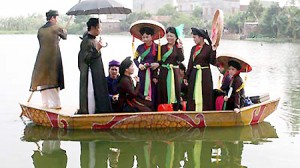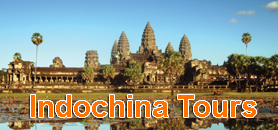Foreign experts discuss intangible cultural heritage preservation
 Vietnam is one of the first pioneers to implement the 2003 Convention for Safeguarding Intangible Cultural Heritage, said UNESCO Director General Irina Bokova.
Vietnam is one of the first pioneers to implement the 2003 Convention for Safeguarding Intangible Cultural Heritage, said UNESCO Director General Irina Bokova.
At a recent international seminar on experiences and orientations for preserving intangible cultural heritage in Quang Nam province, Ms. Bokova said the Convention has been adopted by 100 nations around the world in a bid to protect their cultural heritage.
She spoke highly of the Vietnamese government’s determination and action to encourage the entire population to get involved in protecting and upholding intangible cultural heritage, and sharing valuable historical assets and cultural diversity.
Vietnamese localities should make greater preservation efforts for the long term, she said, adding that culture gives birth to heritage and plays a key role in the development process.
It is essential for UN member countries to set specific goals to preserve heritage in a sustainable manner, the UNESCO General Director noted.
Professor Dr. Dawnhee Yim from Donggok University in the Republic of Korea (RoK) shared some experiences in safeguarding intangible cultural heritage.
Over the past four decades, masterpieces of the oral and intangible heritage of humanity have become a focal point in conservation policies of the Convention on Protecting Intangible Cultural Heritage in the RoK
However, he said, rapid modernization and urbanization has created changes in time-honoured traditions, which may pose a threat to intangible cultural heritage such astraditional customs and rituals.
Dawnhee Yim was worried about the possible disappearance of some cultural assetsso the Korean government has allowed some changes in intangible cultural heritage as stipulated in the UNESCO 2003 Convention.
Professor Dr. Roger L. Janelli from Bloomington University in the US highlighted the importance of the concepts of tangible and intangible in cultural heritage. He cited the Pyramids in Egypt and the Ho Dynasty Citadel in Vietnam as typical examples of tangible heritage.
These heritage sites are of great significance to local people and have become symbols of their nations. Similarly, festivals and religious rituals are vivid examples of intangible heritage featuring traditional costumes, musical instruments and other items.
Dr. Tvrtko Zebec from the Croatia Institute of Ethnology and Folklore Research suggested making digitalized documents of cultural heritage.
Writings, photographs, videos and audio files are a vital source of input for advertising culture and establishing a network of heritage owners. This would help researchers and scientists in their work and offer the public easier access to heritage documents. It will also make it easier and more convenient for heritage owners, cultural organizations, policy makers and Tour Operators to fully tap the potential of cultural heritage, he added.
Go to homepage: Click here
Source: vietnamtourism.gov.vn
Also see:
- Hanoi’s traditional craft villages join World Crafts Network
- Yen Tu Spring Festival opens
- Hon Dung community tourism village recognized
- Sapa Việt Nam’s mountain range in top place to travel in 2019
- The Southern Fruit Festival 2017 will last for 3 months
- Cheo plays to grace Ha Noi stage every Saturday
- Vietnam among top 10 budget honeymoons: Lonely Planet
- Celebrate Lunar New Year in Sapa
- Ideal Places For Travelling By Motorbike In Vietnam
- Da Lat And Sa Pa Among Best New Destinations In Asia
- Homestay in Ta Van Village, Sapa
- Thang co’ – A traditional dish of Mong ethnic group






















